Life certainly had its ups and downs in the Roman Empire, but a new study suggests that mill-workers took long vacations during autumns.

When the great watermills at Berbegal were built in the 2nd century, they were the very best of what science had to offer: 16 huge water wheels stretching downhill in pairs, cascading from one pair to the other, attached to massive wheels that milled grain into flour. It must have been a truly amazing complex, and probably a very efficient one.
Not much has remained today of the wooden complex, but the mineral-rich waters which flowed through the mills created the perfect scenario for archaeologists — they precipitated carbonate deposits, forming casts of the woodwork. Although the wood itself has decayed, these casts are still preserved, providing unique insights into the structure.
Even then, the wooden structures would have required constant maintenance and replacement work. A comparison of the microstratigraphy of some of these fragments reveals clear evidence of maintenance of the Barbegal mills and shows that wooden structures were replaced approximately every 5 to 10 years, dictated by the rate of mold and decay, researchers write. Periodic maintenance is known from medieval mills and was typically required at these intervals.
But things go even deeper.
These carbonatic casts also preserved some of the wood’s organic molecules, and thanks to modern analysis techniques, scientists can go even deeper: they can analyze the different isotopes of carbon and oxygen, revealing how and when the watermills would have been used. Researchers know, for instance, that isotopes of oxygen and carbon occur in different ratios in different seasons. Looking at 142 cast fragments from earlier excavations, they found a seasonal pattern associated with the milling process.
[panel style=”panel-default” title=”Heavy cleaning” footer=””]Of course, one might wonder why the Romans didn’t clean up the carbonatic deposits on their wooden mills. Simple math comes in handy: for a 2-m-long wooden flume consisting of 2-cm-thick pine wood boards, a 5 cm carbonate crust would have added about 170 kg to its total mass, making removal pretty difficult. [/panel]
Basically, the mills were only used from winter to the early summer — workers had the late summer and the entire autumn to themselves, or were assigned different tasks.
It’s not clear why this happens, and it’s not clear exactly what the millers were doing with their time off. But the researchers do note, however, that this seasonal pattern matches with the Roman shipping season. Roman shipping activities typically peaked in the spring and halted in late autumn, which is precisely in accordance with the cyclical period of operation of the Barbegal mills. The bread made at Berbegal could have been used produce bread for these ships, as it’s unlikely that the mills would have been used for urban food production, given the significant gap. An alternative explanation, that the mills were used to produce flour for the army, is unlikely because no large military concentration is known from the area for the period of activity of the mills.
[panel style=”panel-default” title=”Military bread” footer=””]Panis nauticus (the nautical bread), equivalent to panis militaris (military bread) or buccelatum (28–30), was a major staple aboard Roman ships. After it was double baked, it was suitable for long-term storage, just like ship’s bread typically used in later periods. A similar situation has been proposed to explain the large number of bakeries in Ostia, the harbor city of ancient Rome.[/panel]
Researchers also found that the initial fabric of the main deposits is identical to calcite formed in closed aqueduct channels with fast flowing water, which suggests that they were somewhere in the shade, or more likely, inside the building. But later on, they found evidence of increased photosynthetic activity, indicating that there was more exposure to sunlight.
“This suggest that the Barbegal mills either were shaded by overhanging roofs or, more likely, were enclosed within buildings” during the initial phase, researchers write, “and that these structures were partly removed or collapsed during the final phase of porous carbonate deposition. As a result, the water mills were exposed to sunlight, triggering the growth of photosynthetically active organisms.” Operation of the water wheels inside buildings may also explain why the carbonate deposits were not regularly removed from the woodwork.
The Berbegal complex was the largest and earliest known industrial utilization of hydropower by any society, and seems to contradict the idea that the Greco-Roman society was technologically stale. The watermills exhibit a series of impressive innovations which only re-appear during medieval times. Researchers suggest that there are other similar complexes in the area just waiting to be discovered.
“Because both the location of large urban centers and harbors in the Roman Empire, as well as the sites of large aqueducts and their springs, are known, it should be possible to predict the locations of further large and hitherto undiscovered mill complexes,” researchers conclude.


